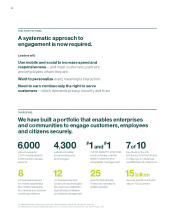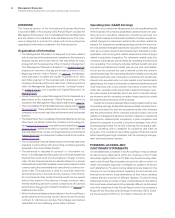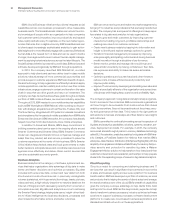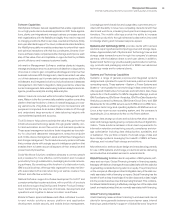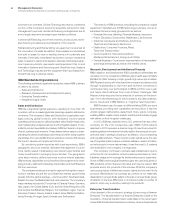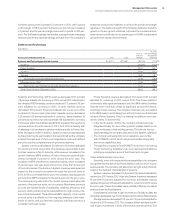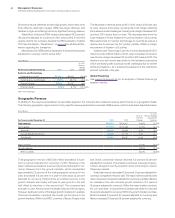IBM 2013 Annual Report Download - page 32
Download and view the complete annual report
Please find page 32 of the 2013 IBM annual report below. You can navigate through the pages in the report by either clicking on the pages listed below, or by using the keyword search tool below to find specific information within the annual report.31
Management Discussion
International Business Machines Corporation and Subsidiary Companies
IBM offers a full array of cloud delivery models, including private
clouds, public clouds and a hybrid cloud that includes a mix of both.
The company enables clients to build private, on-premises cloud-
based environments that have the control, security and isolation
required for their most mission-critical workloads. IBM also offers
public cloud services, including the newly acquired SoftLayer plat-
form that provides an infrastructure and ecosystem for middleware
and applications. IBM’s public cloud services can be simply provi-
sioned as a self service, pay-as-you-go consumption model. IBM’s
software defined environments can provide a seamless integration
across private and public cloud models, with interoperability, porta
-
bility and scalability to help clients realize the full value of cloud.
In the new era of computing, IBM’s plans to enable nearly every-
thing as a digital service. During 2013, IBM made several cloud-
related strategic announcements, notably:
• IBM’s Watson technology is being made available as a
development platform in the cloud to enable a worldwide
community of software application providers to build
a new generation of apps infused with Watson’s cognitive
computing intelligence.
• The acquisition of SoftLayer is enabling IBM to deliver
industry-leading cloud solutions that offer the security,
privacy and reliability of private clouds and the economy
and speed of a public cloud.
• New fast-start industry solutions, which are hosted on a private
cloud using SoftLayer and offered as a managed service
through Global Business Services, designed to meet growing
demand from clients for rapid deployment, implementation
and experimentation.
• The acquisition of Xtify Inc., a leading provider of cloud-
based mobile messaging tools that help organizations
improve mobile sales, drive in-store traffic and engage
customers with personalized offers.
• An open-standards IBM cloud platform that provides
capabilities to power the next generation of cloud and
mobile application development and services.
Growth Markets
IBM continues to invest in growth markets where many countries
and companies are embracing big data, mobile, social and cloud,
often at faster rates than mature countries. In China, for example,
32 percent of consumers make their purchases online, compared
to only 14 percent of consumers globally. In Africa, 18 percent of the
continent’s GDP is expected to be handled through mobile money
transfers by 2015, while in Singapore, citizens spend 40 minutes on
average each day on Facebook, compared to less than 25 minutes
in the United States. IBM is helping clients in growth markets capitalize
on these trends. For example:
• In Mexico, IBM is using its analytics tools to enable
Banorte-Ixe Bank to know and service its more than
13 million customers as individuals.
• Using IBM’s Big Data technologies and predictive analytics,
Da Nang’s (Vietnam) traffic control center is better forecasting
and preventing potential congestion and better coordinating
city responses to issues like accidents and adverse weather.
• In Saudi Arabia, the company developed a public health
solution for disease management that was implemented
with the Saudi Ministry of Health to help manage the risk of
infectious and communicable diseases across the Kingdom.
• Faced with rising fuel costs and a goal to reduce greenhouse
emissions, Jet Airways, India’s premier international airline,
turned to IBM to more accurately calculate, track and report air-
craft emissions and reduce fuel usage.
IBM continues to build out its shared services facilities and talent to
support its clients in growth markets. In China, the company has
increased its Big Data software skills, and it will leverage an IBM
Integrated Managed Services Centre to capture the significant
growth in cloud. In November 2013, IBM opened its first Africa
Research Lab in Kenya, IBM’s 12th lab worldwide. The facility will
conduct applied and exploratory research into the challenges Africa
faces, and deliver commercially viable solutions to help improve the
lives of people across the continent.
Summary
IBM’s strategy is one of innovation, transformation and a constant evo-
lution to higher value. The company has steadily remixed its portfolio
and business model to reflect its strategic beliefs and pursue its growth
initiatives. IBM has a balanced history of exiting commodity businesses
that no longer fit the high-value model while investing in strategic
acquisitions and organic capabilities. In 2013, the company invested
$3.1 billion for acquisitions, $3.8 billion in net capital expenditures and
$6.2 billion in research and development. The company has acquired
more than 150 companies since 2000 to bolster its portfolio in areas
like big data and analytics, cloud and systems of engagement.
As the company looks ahead to 2014 and beyond, it will continu-
ously transform itself to take advantage of new opportunities and
pursue bold new plays in areas such as Watson solutions, new offer-
ings for big data and analytics, the mobile enterprise and high-value
cloud services. IBM will continue to deliver differentiated client value
based on its sustained investments in research and development, its
engaged employee base, industry expertise, global reach, and the
breadth and depth of the company’s technologies and capabilities.
Business Model
The company’s business model is built to support two principal goals:
helping enterprise clients to become more innovative, efficient and
competitive through the application of business insight and IT solu-
tions; and providing long-term value to shareholders. The business
model has been developed over time through strategic investments
in capabilities and technologies that have superior long-term growth
and profitability prospects based on the value they deliver to clients.
The company’s global capabilities include services, software,
systems, fundamental research and related financing. The broad
mix of businesses and capabilities are combined to provide inte
-
grated solutions to the company’s clients.
The business model is resilient, adapting to the continuously chang-
ing market and economic environment. The company continues to
divest certain businesses and strengthen its position through strategic
organic investments and acquisitions in higher-value areas. In addition,
the company has transformed itself into a globally integrated enterprise
which has improved overall productivity and is driving investment and
expanding participation in the world’s fastest growing markets.



